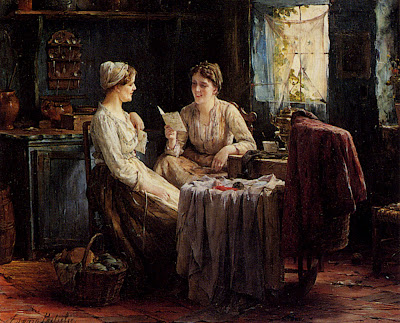Edward Antoon Portielje (1861 - 1949), a late nineteenth-, early twentieth-century Belgian painter from Antwerp, showed an interest in seemingly disparate subjects; on the one hand, his images of the domestic woman show a sensitivity toward the female sitter and the encompassing environment, while his depictions of Dutch fisherman suggest a versatility in choice of subject matter and execution. Modern audiences will be more familiar with his works dedicated to the perpetuation of the cult of the female, which romantically look back to eighteenth-century style artists and show glimpses into aspects of daily life.
Edward Antoon Portielje, the son of the Dutch artist Jan Frederik Pieter Portielje, primarily a portrait painter, was born on February 8th, 1861 in Antwerp. Edward’s brother, Geerard Jozef, was also an artist in the family tradition. Edward undertook artistic training at École des Beaux-Arts in Antwerp, studying under Charles Verlat, who also taught Van Gogh during the early 1880s. That Portielje and Van Gogh were studying at the same time shows to what point artists diverged during this period. Portielje maintained a refined execution with traditional themes while other artists in Belgium, as in France, began experimenting with other methods of representation. Many of Portielje’s interior scenes are modeled around the fresh color provided by studies of flowers and other botanicals that contrast with the otherwise somber tone of many of his works. These are the elements, in both Portielje’s and Dutch painting in general during this period, that were described as “a small piece which stops us and seduces us.”
(FADA at fada.com) Afternoon Tea Rehs Galleries, Inc., New York
Private collection, Georgia
From fada.com
Letter
Knotting Net
Images from arthistoryreference.com
The Letter
From oilpaintingsell.com
Two Young Women Sharing a Letter
Two Young Women Sharing a Letter (detail)
Two Young Women Sharing a Letter (detail)
Images from liveauctioneers.com
Working the Lace
From fineartlib.info
The Doting Mother
From theenglishmanusa.com
Portielje held his first foreign exhibition in The Hague in the Netherlands in 1887. In 1891, The Antwerp Salon sold his work to the Museum of Fine Arts in Antwerp. Two years later, The Museum of Namur in Belgium also purchased one of his works during an exhibition; his painting was called, "Solace."
By the end of the 19th century, he had also displayed his works in Mons and Reims, France as well as in Leige, Middelburg, Spa and Verviers, Belgium. In the meantime; he developed an extensive customer base from Antwerp to Brussels to Rotterdam.
Portielje's reputation as a leading genre painter grew, capturing the attention of discerning collectors abroad, especially in the United Kingdom as well as the United States. On the occasion of Edward's eightieth birthday, the newspaper, "De Dag" ran a feature on the artist. The article began as follows: "We have had the privilege to visit the workshop of one of the greatest living Flemish painters: Edward Portielje."
On December 18, 1949, Edward Portielje died in his apartment in the Antwerp Tower. The newspaper, "De Gazet van Antwerp" described him as follows: "With the death of Edward Portielje at the age of 89, we lose an important Antwerp figure in the world of art. This highly appreciated painter was considered to be one of the greatest artists over many years and scored an extraordinary success with every one of his exhibitions. His name will be definitively linked with Zeeland's little houses, a theme he made into a genre of its own through his technical virtuosity and exceptional productivity."
Today, Edward Portielje's works can be found in many public and private collections, worldwide. His work is also represented in the Antwerp Museum of Fine Arts, the Chicago Museum of Fine Art, the National Gallery in Melbourne and in museums in Sydney, Australia, Bourges, and Bordeaux, France.
(jmstringergallery.com)
Portielje’s contributions to Belgian painting earned him the respected honor of knighthood from the state. Portielje’s intimate interior scenes, in the artistic lineage of Belgian painter Jean-Baptiste Madou and the most recognizable of Portielje’s image for modern-day audiences, offer light-hearted reflections of leisure time rendered in warm tones that give his images such immensely appealing qualities. His reliance on local exhibitions shows his patriotism to the creation and advancement of typically Belgian art, in both theme and mood.
(FADA at fada.com)
Note: I found these images (above) from all over the web. If you own a photo’s copyright and think this page violates Fair Use, please contact me.
Note: I found these images (above) from all over the web. If you own a photo’s copyright and think this page violates Fair Use, please contact me.












Tidak ada komentar:
Posting Komentar